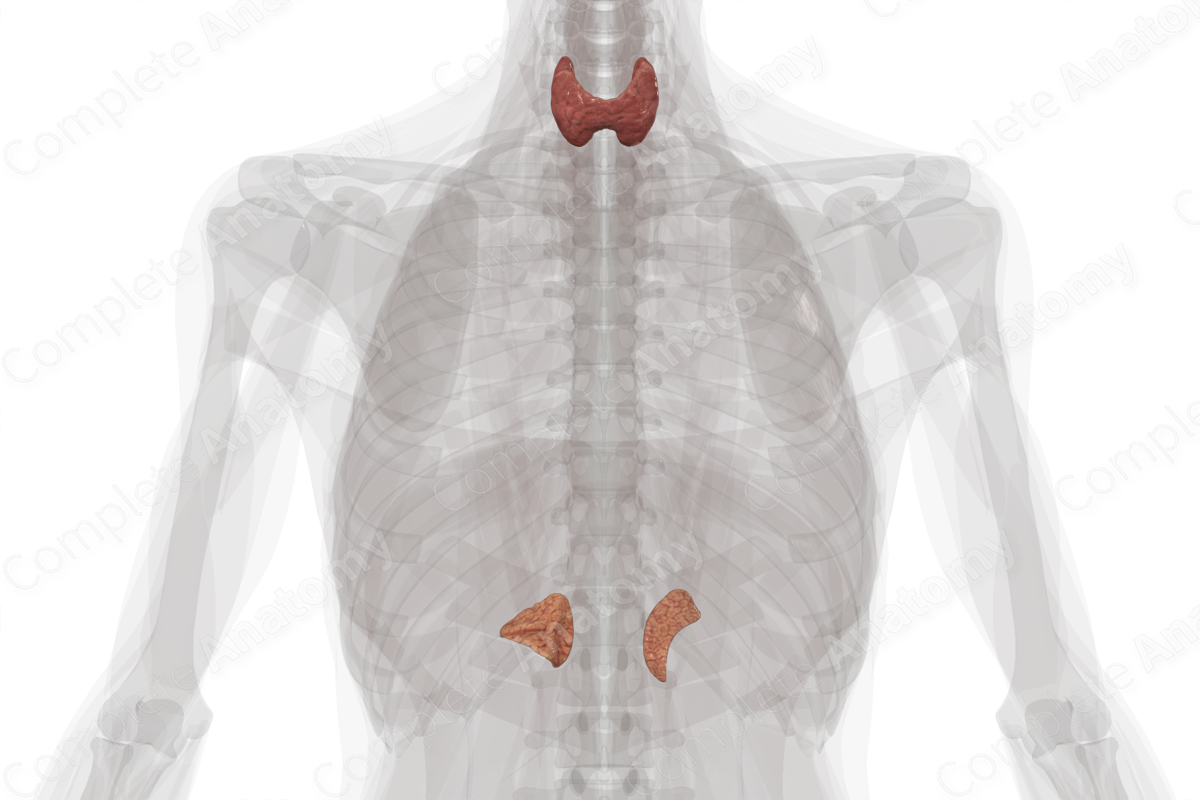
Description
The endocrine system is a collection of highly vascularized organs/glands, which actively synthesis, store, and secrete hormones into the blood system. Hormones are circulated around the body and act on distinct targets that regulate homeostasis through negative or positive feedback loops (Kumar and Clark, 2009).
Hormones regulate many physiological and behavioral activities including sleep, mood, digestion, stress, growth and development, reproduction, lactation, and movement (Standring, 2016).
The major endocrine glands include the:- pituitary gland;- pineal gland;- thyroid gland;- parathyroid glands;- suprarenal glands;- pancreas;- gonads (ovaries and testis).
Other organs, such as the liver, kidneys, and heart act as secondary endocrine glands.
Hormones are biosynthesized by an intracellular cascade of events. An inactive “prohormone” undergoes several chemical conformational changes until an ‘active’ hormone is synthesized. There are several chemical structures of active hormones, including polypeptide, glycoproteins, steroids, and amines. Active hormones are stored in membrane bound vesicles and released into the blood stream, often induced by an intracellular calcium-dependent response (Kumar and Clark, 2009).
The body’s response to the endocrine system is normally much slower and longer lasting when compared to the response to the nervous system. Negative and positive feedback loops, controlled by the hypothalamus and pituitary gland in the brain, regulate the body’s response to hormones (Standring, 2016).
The pituitary gland is a pea-sized gland that rests in the sella turcica of the sphenoid bone of the skull. It’s often termed the ‘master gland’ as it provides a link between the central nervous and the endocrine systems. The pituitary gland is connected to the hypothalamus of the brain, via the pituitary stalk. This close anatomical relationship is vital for the regulation of hormones, via the hypothalamo-pituitary axis. Hormones produced by parvocellular neuroendocrine motor neurons in the hypothalamus travel by the portal system to the pituitary gland. This stimulates or inhibits the pituitary gland to produce another hormone, which is subsequently released into the blood stream. The pituitary hormone binds to its bodily targets and stimulates a physiological response and often a release of a different hormone by one of the glands of the endocrine system. This hormone is then detected by receptors in the pituitary gland and hypothalamus and a negative feedback loop is exerted (Kumar and Clark, 2009).
The pineal gland is a small endocrine gland in the brain that is vital for control of the circadian rhythm. It produces melatonin and serotonin derived hormones (Macchi and Bruce, 2004).
The thyroid gland is located inferior to the thyroid cartilage in the neck and consists of two lateral lobes connected by an isthmus (Moore, Dalley and Agur, 2013). The thyroid gland is responsible for the production of iodine-containing hormones, triiodothyronine (T3), thyroxine (T4), and calcitonin. Thyroid hormones control many bodily functions including metabolism, heart rate, and normal development (Standring, 2016). An over active (hyperthyroidism) or underactivity (hypothyroidism) thyroid gland are common endocrine problems (Kumar and Clark, 2009).
Four parathyroid glands are located posterior to the lobes of the thyroid gland and are responsible for synthesizing parathyroid hormone (PTH). PTH is responsible for bone remodeling by calcium and phosphorus distribution (Kumar and Thompson, 2011).
The suprarenal glands are located anterosuperiorly to the upper poles of each kidney. They’re responsible for producing three classes of hormones, essential for a range of biological functions. These include glucocorticoids, mineralocorticoids, and androgens. Glucocorticoids are responsible, but not limited to, gluconeogenesis, glycogen, protein, and fat deposition, sodium retention, and potassium loss. Mineralocorticoids act on the balance of sodium and potassium of the kidneys. Androgens are metabolized peripherally into testosterone and dihydrotestosterone (Kumar and Clark, 2009).
The pancreas is located retroperitoneally in the abdomen. It has both an endocrine and an exocrine function. The pancreas endocrine function is responsible for blood sugar control through the production of insulin, glucagon, and somatostatin (Kumar and Clark, 2009).
The gonads are responsible for both sex hormone and gamete production. In males, the testes synthesis sperm and androgens. In response to pituitary gonadotropins, Leydig cells synthesis testosterone and anti-Müllerian hormone. Testosterone is responsible for normal testicular development and the onset of puberty (Standring, 2016). In females, the ovaries are responsible for producing competent oocytes and sex hormones, including estrogen and progesterone. Estrogen is responsible for the onset of puberty and development of secondary sex characteristics. During each monthly menstrual cycle, hormone levels fluctuate and prepare the uterus for implantation of a fertilized oocyte (Standring, 2016).
Related parts of the anatomy
References
Kumar, P. P. J. and Clark, M. L. (2009) Kumar and Clark's Clinical Medicine. Kumar & Clark's Clinical Medicine: Elsevier Science Health Science Division.
Kumar, R. and Thompson, J. R. (2011) 'The regulation of parathyroid hormone secretion and synthesis', J Am Soc Nephrol, 22(2), pp. 216-24.
Macchi, M. M. and Bruce, J. N. (2004) 'Human pineal physiology and functional significance of melatonin', Front Neuroendocrinol, 25(3-4), pp. 177-95.
Moore, K. L., Dalley, A. F. and Agur, A. M. R. (2013) Clinically Oriented Anatomy. Clinically Oriented Anatomy 7th edn.: Wolters Kluwer Health/Lippincott Williams & Wilkins.
Standring, S. (2016) Gray's Anatomy: The Anatomical Basis of Clinical Practice. Gray's Anatomy Series 41 edn.: Elsevier Limited.




